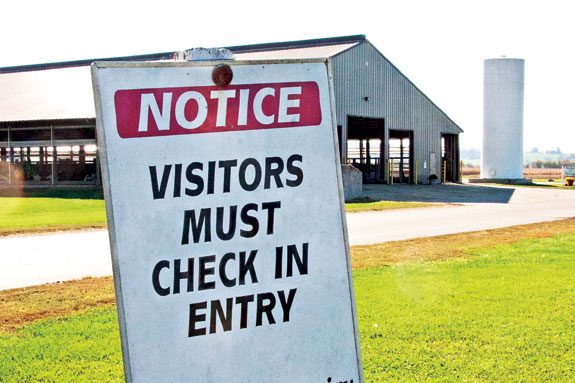How well prepared are you for a health crisis on your farm or in the dairy industry at large? Are you doing things that help avert a crisis? Do you incorporate processes in your management that minimize risks of introducing or spreading costly infectious diseases to your cows? This fall I participated in a “dairy industry crisis drill” in Denver. The event was sponsored by DMI, NMPF, the U.S. Dairy Export Council, Milk PEP and IDFA.
The intent of the exercise was to challenge and prepare people involved at multiple levels of the dairy industry for a major health safety crisis.
The participants included a wide range of dairy industry representatives including producers, veterinarians, regulatory authorities, processors, academics, extension personnel and promotion association members.
The imaginary crisis was an outbreak of foot-and-mouth disease, which is presently not in our country, and the exercise was intended to help participants understand and deal with the media, industry communications, chain-of- command issues and the variety of challenges that occur in the event of a large-scale crisis in the dairy industry.
Participating in this exercise was a wake-up call for me. I thought I understood the extent of the problem, but the speed of events, the intricacies of communication and the layers of political decision-making pointed out by play-acting a scenario were mind-boggling. I encourage everyone involved in the dairy industry to take the opportunity to prepare themselves with such training when the opportunity arises.
Emergency preparedness requires that we think about future possibilities and challenges and assure that we are in the best position possible when such a challenge occurs. As we stay busy dealing with our many daily tasks, it is easy to overlook the value of forward thinking that includes preparing for unexpected events.
The effect of a foot-and-mouth disease (FMD) outbreak in the U.S. would be devastating. It would likely affect numerous dairies in a short amount of time and become a regional and national crisis.
When the FMD outbreak occurred in the UK in 2001, it was such a disruptive event that it prompted many people in the U.S. dairy industry to consider stricter biosecurity measures in order to prevent an outbreak in this country.
Beyond preparing for such a major disaster, however, the crisis preparedness drill also brought to my mind the more mundane challenges that we face with great frequency ... There are numerous other infectious problems that do affect U.S. dairy cattle and which significantly impact herd health and limit profitability.
We would do well to pay attention to these challenges, alter some of our management practices and benefit by maintaining healthier, more productive dairy herds. In the long run, management that decreases infectious disease transmission will serve us well when a foreign animal disease does cross our borders.
There is a lot of disease in our national dairy herd. Many of these problems are infectious, meaning they’re caused by microorganisms that invade cows, cause illness, compromise animal welfare and severely affect profitability. Most of these infectious diseases are contagious, meaning infected animals shed the microorganisms so they spread to other cows.
The USDA National Animal Health Monitoring System dairy surveys have shown increasing occurrence of clinical mastitis, lameness and respiratory problems from 1996 through 2007. Specifically the survey estimated that each year clinical mastitis affects 16.5 percent, lameness affects 14.0 percent and respiratory disease affects 3.3 percent of dairy cows. Many of these diseases are infectious and contagious.
Consider the impacts of BVD, salmonellosis, mycoplasma mastitis, Johne’s disease and hairy heel warts. Every one of these can have a devastating effect on a herd. In many herds these problems are already present and the challenge is to reduce the infection level. These problems represent massive costs due to lost production, lost cows or control measures.
They are great examples of the old adage that “an ounce of protection is worth a pound of cure.” For a herd that does not have one of these problems, or where occurrence is low, preventing its introduction to the farm is obviously a good idea. And yet too few dairies really practice biosecurity measures to accomplish this.
The NAHMS dairy 2007 study showed that between 12 and 14 percent of operations routinely introduce bred heifers or lactating dairy cows to the operation. Approximately 40 percent of operations bring some class of dairy animal onto the operation. Less than 25 percent of herds require any testing of individual animals coming onto their farm and less than 30 percent require any information about incoming cows from the herd of origin.
There is a lot of movement of dairy cows in the U.S. If a problem such as foot-and-mouth disease enters the country, this cow movement will be a major liability in trying to prevent the spread of the problem. But on a day-to-day basis, this movement presents another risk that should be very important to dairy producers. That is the spread and introduction of very costly diseases that occur with frequency in the national dairy herd.
It is worth every producer’s time to consider the downside risks of weak biosecurity measures. There are straightforward ways to reduce these risks. Producers should strive to attain closed-herd status. When a producer decides to bring animals onto the farm, they should consider purchase practices that decrease the risk of herd disease exposure.
The best way to do this is to buy cattle from herds known to be free of the disease. A less powerful, but still valuable option is to test cattle before they are introduced.
Increased awareness and efforts to minimize the spread of infectious diseases are important components of crisis preparedness. Whether we are talking about a national crisis such as FMD, or an individual herd crisis such as mycoplasma mastitis, dairy producers and veterinarians can take steps to be better prepared than we are at present. PD
Frank Garry is a professor and coordinator of the Integrated Livestock Management Program at Colorado State University.
PHOTO
TOP RIGHT: Many of these problems are infectious, meaning they’re caused by microorganisms that invade cows, cause illness, compromise animal welfare and severely affect profitability. Photo by PD staff.

Franklyn Garry
Professor
Department of Clinical Sciences
Colorado State University
franklyn.garry@colostate.edu












